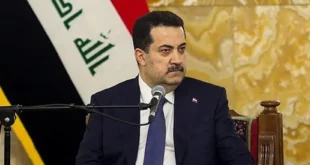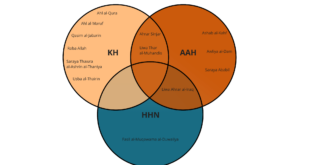The Hamas attack on Israel on October 7, 2023 came out of the blue. The Palestinian terrorist group struck at a time when the White House believed there wasn’t any major threat to stability in the Middle East and was expecting a process of normalizing the relationship between Israel and Saudi Arabia. No one anticipated a new Arab-Israeli war.
President Joe Biden’s administration took time to assess the situation prior to formulating a geo-strategic response. It then drew up the outline of an American response, that would secure US interests and manage those of its regional partner, namely Israel and the Arab-Sunni states.
As the US government saw it, Hamas, a close partner of Tehran and financial and military dependent of Tehran, was the driving force in the crisis. The Palestinian terrorist group had hoped the surprise attack on Israel, coupled with the kidnapping of close to 250 hostages, would nullify the deterrence capability of its adversary and sabotage the American plan to normalize Saudi-Israeli relations.
In that context, in addition to giving Hamas the green light to attack Israel, the Iranian government also gave a green light to its regional allies, including Hizballah guerrillas in Lebanon, to launch a series of attacks on northern Israel. Shiite groups in Syria and Iraq and Yemen’s Houthi rebels also carried out attacks.
Policymakers in Washington were worried that Israel was distraught by the Hamas attack, the kidnapping of the hostages, Hizballah’s blitzes, and the loss of their deterrence power. As a result, US officials were concerned that Israel’s military response could transform into a major regional military conflagration involving Israel and Iran, especially if the Israel Defense Forces were to attack Hizballah’s bases in Lebanon.
In case of a war between Israel and Iran, the United States would have little choice but to come to the Jewish state’s assistance and find its military forces directly drawn into the new war in the Middle East.
Biden Bear-Hugs Netanyahu
Against this backdrop, Biden decided that to avert such a scenario the United States needed to provide a sense of security to its ally, thus giving US military and diplomatic support as it launched an attack aimed at destroying the Hamas military and political infrastructure.
Biden, therefore, flew to Israel to demonstrate American support. He also dispatched two American aircraft carriers and Marine units to the Middle East to deter Iran and Hizballah from making offensive moves against Israel.
The initial “bear-hug” that Biden gave Prime Minister Benjamin Netanyahu, as the media referred to it, proved to be an effective approach by Biden, who succeeded in pressing the Israeli leader to refrain from attacking Hizballah’s sites in Lebanon and to allow some humanitarian aid into the besieged Gaza Strip.
The US government has also expressed reservations about the way Israel has conducted military operations in Gaza, including the use of airstrikes that resulted in the killing of thousands of Palestinian civilians and the destruction of entire neighborhoods.
The Israeli approach was condemned by the majority of UN members, especially by those belonging to the so-called Global South. Some European governments also expressed reservations over Israel’s conduct. Israel was also criticized by left-leaning Democratic lawmakers, such as Sen. Bernie Sanders, who called on the White House to press the Israeli government to move towards a ceasefire in Gaza. The idea has been rejected by those who insist that they would not end the fighting without the destruction of Hamas.
Meanwhile, the Israeli government came under public pressure to negotiate the release of the hostages held by Hamas through Qatari and Egyptian mediation. And, indeed, it agreed to suspend fighting for a few days on November 30, 2023, to allow for the release of about 100 hostages.
Biden-Netanyahu Clash
There were signs of growing tensions between Washington and Jerusalem over postwar strategy.
The Biden administration has indicated that it wanted to see the Palestinian Authority—currently ruling the West Bank—take over control of the Gaza Strip after Hamas is removed from power. Washington has also hoped to launch a diplomatic initiative in support of Saudi Arabia and other Arab-Sunni governments. Under this plan, the West Bank and the Gaza Strip would become the nucleus of an independent Palestinian State that would live side by side in peace with Israel.
Netanyahu, who heads the most right-wing government in Israel’s history, has rejected the idea of handing over the control of Gaza to the Palestinian Authority and expressed opposition to taking steps to establish an independent Palestinian state.
But Israel’s dependency on American military and diplomatic support has left the government no choice but to change tactics in the Gaza Strip and to shift to a new phase that relies less on airpower, has narrow targets, and results in fewer civilian casualties. In any case, while Israel may have killed hundreds of Hamas fighters there were no indications that the movement’s top leaders have been affected.
At the same time, around 130 people were abducted from Israel on October 7, including several Americans, are believed to be still in captivity in Gaza. Hamas has ruled out any further hostage releases until Israel agrees to a “full cessation of aggression.” Israel has rejected that demand, but may eventually have to agree if it wants to see the hostages return alive.
The Strategic Stakes
On one level, the war in Gaza could be seen as just another round of fighting between Israel and Palestine, or a phase in the century-old struggle between Jews and Arabs over the territory of Palestine/Land of Israel.
But this time the danger is that the war between Hamas and Israel could not be contained as a local ethnic-religious conflict. In a way, the role Iran played in orchestrating the war could lead to the regionalization of the conflict in the form of a military confrontation between Israel, a nuclear power, and Iran, which has come close to acquiring its own nuclear military capability.
At minimum, the Hamas attack has shifted the balance of power in the Middle East in the direction of Iran and its proxies, while weakening the position of the United States and its partners. Adding to a sense of Iranian aggressiveness, there were reports that Tehran has considerably ramped up its production of uranium in recent weeks, reviving fears that it may be speeding toward the capability of fabricating several nuclear weapons.
A failure to obstruct this Iranian drive for regional supremacy would be a geopolitical loss for the United States and undermine its global position relative to China and Russia. The nightmare scenario consists of Iran and its proxies succeeding in establishing a new balance of power in the Middle East under which Israel is left damaged, Hamas is not destroyed, and the normalization of relations between Israel and Saudi Arabia remains stalled. While all this would not necessarily amount to Iranian “victory,” it would give Tehran more influence.
Containing Iran
Hizballah, coordinating its moves with Iran, has continued to attack Israeli targets. Iran also started providing intelligence and weaponry to its Houthi allies in Yemen who were starting to target ships, including commercial vessels passing through the Red Sea. At first, the Biden administration refrained from responding to strikes by Iran’s proxies against American forces in Syria and Iraq, or, for that matter, to the Houthis’ threat to international shipping, through direct military response.
The danger is that the Iranians may view this American caution as weakness and, notwithstanding Biden’s rhetoric and the deployment of US aircraft carriers to the Middle East, the American president is worried about the potential of direct US military intervention. That could lead to war with Iran at a time when the United States is confronting Russia in Ukraine and is worried about the threat of a Chinese attack against Taiwan.
Iran also recognized that the United States does not have the military resources to fight on three fronts and that the American people don’t want to be drawn into a new quagmire in the Middle East. And they wondered: When push comes to shove, would Biden be ready to pull the trigger?
Biden Pulls the Trigger—To a Point
After weeks of warning of retribution against the Houthi rebels, who were threatening vital maritime trade routes, the United States and United Kingdom responded in mid-January. The US Navy fired dozens of Tomahawk cruise missiles towards Yemen from the Red Sea, while British jets launched laser-guided Paveway bombs at selected targets.
Biden’s patience and fear of escalation apparently ran out. The strikes gave some credibility to the warning that the Houthis would face “consequences” if they kept up their piracy and likely helped restore American deterrence in the region. But it’s not clear whether they did, with the Houthis continuing their attacks on shipping in the Red Sea and the Iranians arming them and providing them with real-time targeting intelligence.
In fact, when the United States took out Houthi launching facilities—radar and weapons depots in Yemen—it struck at night, after clearly telegraphing its intentions, and avoiding targeting the Houthi leadership behind the Red Sea shipping attacks.
The point is that Iranian officials seem to believe that an escalating conflict in the Middle East will increase the costs to the United States and the West without risking a wider war. From their perspective, continuing escalation of the conflict would be cost-effective, since the United States would never take steps that risk war with Iran and would do everything to minimize those already existing.
Averting a War and Making Peace
In a way, American policies during the Gaza war have been driven by an interest in averting a war with Iran: pressing Israel to avoid a full-blown military confrontation with Hizballah, restricting its military operations in the Gaza Strip, and trying to get Israel to avoid civilian casualties.
Ultimately, the United States would like to see Israel destroy the military power of Hamas and erode the power of Hizballah, but it is preventing Israel from taking the steps to do so, as they could escalate the conflict and make it more likely that Iran would be able to exert its influence.
At the same time, Biden administration officials believe that the most effective way for them to try to return to the pre-October 7 balance of power in the Middle East is, as national security advisor Jake Sullivan suggested during a presentation at Davos, by reaching a ceasefire in the Gaza War to be followed by the launching a diplomatic initiative. Under such a diplomatic plan Israel and Saudi Arabia would normalize their relationship as part of a process that would include an agreement by Israel to establish an independent Palestinian State and a commitment by the Saudis to rebuild Gaza’s economy.
This plan assumes a lot of things that aren’t necessarily going to happen. Could Hamas be disarmed and marginalized in this process? Would the Palestinians be able to come up with a new and effective leadership that would work with Israel? And in the aftermath of the trauma of October 7 would the Israeli government agree to the establishment of an independent Palestinian state on their borders.
And perhaps most important from the perspective of the geo-strategic chess game between Washington and Tehran: Why would the Iranians and their proxies accept an arrangement that would allow the United States to reassert its position in the Middle East and reverse what they see as their win of October 7?
If anything, there have been growing concerns in Washington in late January that continuing actions against the United States by Iran and its proxies could force a more decisive retaliation on the part of the Americans, resulting in a broader regional war.
Or as national security advisor Sullivan put it, “We have to guard against and be vigilant against the possibility that, in fact, rather than heading towards de-escalation, we are in a path of escalation that we have to manage.” In other words, how to strengthen the chessboard and ensure the pieces don’t fall.
 Eurasia Press & News
Eurasia Press & News




